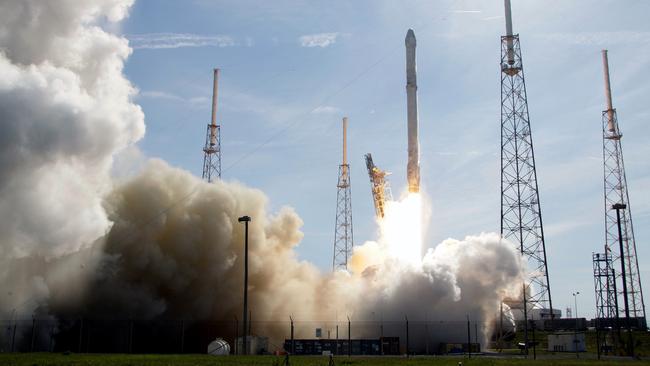SpaceX plans Mars mission ‘as soon as 2018’
Elon Musk’s SpaceX is planning to send an unmanned capsule to Mars, perhaps as soon as 2018.

Billionaire entrepreneur Elon Musk has disclosed plans to send an unmanned capsule to Mars, perhaps as soon as 2018, revealing the first details of his long-term vision for a private enterprise to colonise the red planet.
The announcement, made through Twitter, didn’t include any specifics about the potential mission, and left unanswered all the major technical and funding questions surrounding Mr Musk’s oft-repeated concept to ultimately set up habitats on Mars.
Over the years, he has repeatedly said his top-priority goal — more important than the economic success of his separate space and electric-car companies — is to build colonies on Mars, envisioning thousands of inhabitants served by airline-like flights to and from earth.
In the past, Mr Musk has basically stayed away from describing even the early steps towards what many detractors consider a far-fetched, sci-fi ambition.
But messages indicate Mr Musk’s Space Exploration Technologies Corporation, known as SpaceX, has crafted some definite preliminary plans, and suggest the company is further along than many outsiders had believed in developing versions of its Dragon spacecraft and Falcon 9 rockets aimed at eventually exploring deep into the solar system.
SpaceX, based in California, tweeted that a Mars mission could come “as soon as 2018”.
It also said “Red Dragons will inform overall Mars architecture”, adding “details to come”.
The next-generation Dragon 2 spacecraft presumably would be blasted on its months-long voyage towards Mars by some version of the company’s heavy-lift Falcon 9 rocket. Neither the craft nor the rocket has yet flown, and the Falcon 9 Heavy, years behind schedule, is now slated to have its maiden blast-off late this year. The heavy version has 27 engines, versus nine for the current Falcon model.
The developments highlight SpaceX’s continued emphasis not just on Mars — but on devising hardware capable of gently landing on its surface.
Mr Musk, who founded closely held SpaceX and has built it into a multi-billion-dollar space transportation company, sent two separate tweets discussing the plans. One said: “Dragon 2 is designed to be able to land anywhere in the solar system”, adding that “Red Dragon Mars Mission” is intended to be “the first test flight” of the upgraded capsule.
A major challenge facing SpaceX is devising a system to safely slow a large capsule during its descent through the thin Martian atmosphere. Dragon 2 is expected to weigh substantially more than the unmanned rovers that NASA (the National Aeronautics and Space Administration) has landed on the plant.
Previously, Mr Musk has telegraphed that he expects to unveil some details of his long-term Mars vision at an international conference in Mexico slated for late September. The 2018 timetable is significant because a launch at that time could take advantage of a once-in-a-lifetime close approach of the orbits of Earth and Mars.
If all goes well, SpaceX will start transporting US astronauts to the international space station for NASA starting next year. But as the station orbits relatively close to the earth, much more advanced technology will be required for deep-space missions, including those targeting Mars or even its vicinity.
Until now, Mr Musk has been practically silent about ways to upgrade today’s Dragon capsules or specifics about potential test flights to begin charting a course for Mars voyages.
NASA, which has sketched out its own vision of eventual human exploration and settlement of Mars, has said it will need at least two decades, and well over $US100 billion ($135bn) and extensive international co-operation to send astronauts to orbit the planet. It isn’t clear what Mr Musk’s timeline might be for manned missions.
A SpaceX spokesman said sending Dragons to Mars would “help demonstrate the technologies needed to land large payloads” on the planet, using engines or other technologies that generate thrust”. Such missions would “help inform the overall Mars colonisation architecture SpaceX will reveal later this year”.
The company plans to fund the mission itself, according to the spokesman, “though NASA will offer some technical support” such as space-based government communication networks. The preliminary plans are far enough along that SpaceX and NASA have signed a formal co-operative agreement, which the company spokesman said did not call for any federal dollars flowing to Mr Musk’s team. The cost of the initial test flight wasn’t disclosed.
Mr Musk has never wavered from his commitment to colonise Mars, repeating that goal in interviews, speeches and other public statements. According to Mr Musk, whose company has surprised many aerospace veterans by managing to vertically land spent Falcon 9 boosters next to a launch pad as well as on a floating platform, reusable rockets are the fundamental breakthrough needed to revolutionise access to space.
“It’s a fundamental decision we have to make as a civilisation,” Mr Musk said in Hong Kong this year. Mars was “the next, natural step” because “it’s the only planet” on which “we really have a shot at establishing a self-sustaining city,” he said.
The Wall Street Journal



To join the conversation, please log in. Don't have an account? Register
Join the conversation, you are commenting as Logout